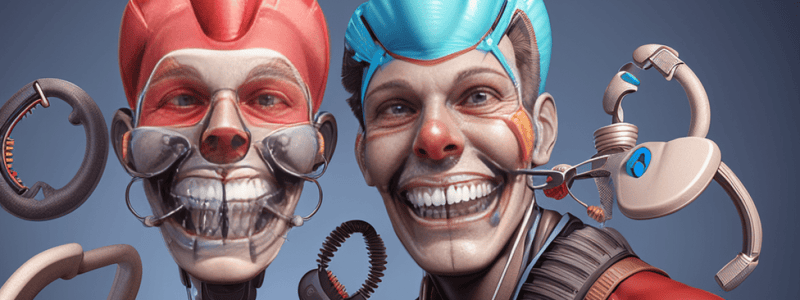Podcast
Questions and Answers
Which of the following is NOT one of Andrews' six keys to normal occlusion?
Which of the following is NOT one of Andrews' six keys to normal occlusion?
- Correct crown angulation (tip)
- Flat curve of Spee (0.0 - 2.5 mm) (correct)
- No rotations
- Correct crown inclination (torque)
What is the key interarch relationship described by Andrews as part of the six keys to normal occlusion?
What is the key interarch relationship described by Andrews as part of the six keys to normal occlusion?
- The distal surface of the distal marginal ridge of the upper first permanent molar contacts and occludes with the mesial surface of the mesial marginal ridge of the lower second molar (correct)
- The mesio-buccal cusp of the upper first permanent molar falls within the groove between the mesial and middle cusps of the lower first permanent molar
- The mesio-lingual cusp of the upper first molar seats in the central fossa of the lower first
- Maxillary Canine has a cusp-embrasure relationship with Mandibular Canine & 1st Premolar
Which characteristic is NOT identified as one of the six keys to normal occlusion?
Which characteristic is NOT identified as one of the six keys to normal occlusion?
- Correct tooth size
- Correct interdental spacing (correct)
- Tight contact points
- Correct tooth angulation
According to Andrews, what should be the range of the flat curve of Spee as a key to normal occlusion?
According to Andrews, what should be the range of the flat curve of Spee as a key to normal occlusion?
Which set of teeth should have a cusp-embrasure relationship as per Andrews' six keys to normal occlusion?
Which set of teeth should have a cusp-embrasure relationship as per Andrews' six keys to normal occlusion?
What type of crown inclinations are part of Andrews' six keys to normal occlusion?
What type of crown inclinations are part of Andrews' six keys to normal occlusion?
What does the term 'Crown angulation (tip)' refer to?
What does the term 'Crown angulation (tip)' refer to?
What does a deep curve of Spee result in?
What does a deep curve of Spee result in?
In which direction does the lower jaw's growth sometimes exceed that of the upper jaw?
In which direction does the lower jaw's growth sometimes exceed that of the upper jaw?
What is the main function of the Facial Axis of molar crowns?
What is the main function of the Facial Axis of molar crowns?
What should be corrected with jackets or crowns, to avoid closing spaces at the expense of good occlusion?
What should be corrected with jackets or crowns, to avoid closing spaces at the expense of good occlusion?
What is the average inter-incisal crown angle?
What is the average inter-incisal crown angle?
What does a rotated molar do in terms of space occupancy?
What does a rotated molar do in terms of space occupancy?
What does 'Tight Contacts' in dentistry refer to?
What does 'Tight Contacts' in dentistry refer to?
'Curve of Spee' ranges from which type of surface to a slight concave surface?
'Curve of Spee' ranges from which type of surface to a slight concave surface?
What causes crowded lower anterior teeth and/or a deeper overbite and deeper curve of Spee?
What causes crowded lower anterior teeth and/or a deeper overbite and deeper curve of Spee?
Study Notes
Andrews' Six Keys to Normal Occlusion
- One of the six keys is not the "Curve of Wilson"
- The key interarch relationship is the "Cusp-embrasure relationship"
- The characteristic "Tooth color" is not identified as one of the six keys
Curve of Spee
- The range of the flat curve of Spee should be 0.5 to 1.5 mm
- A deep curve of Spee results in a decreased overbite
Crown Angulation and Inclination
- The term "Crown angulation (tip)" refers to the mesial-distal angulation of the crown
- Andrews' six keys to normal occlusion include crown inclinations of 10-15 degrees for anterior teeth and 15-20 degrees for posterior teeth
Jaw Growth and Development
- The lower jaw's growth sometimes exceeds that of the upper jaw in the anterior direction
Molar Crowns
- The main function of the Facial Axis of molar crowns is to guide the mandible into a centric relation
Occlusion and Space Management
- Inadequate crown contours should be corrected with jackets or crowns to avoid closing spaces at the expense of good occlusion
- The average inter-incisal crown angle is 130-135 degrees
Space Occupancy
- A rotated molar occupies more space than a normal molar
Tight Contacts
- "Tight Contacts" in dentistry refer to the tight proximal contacts between teeth
Curve of Spee Characteristics
- The Curve of Spee ranges from a flat surface to a slight concave surface
Causes of Crowded Lower Anterior Teeth
- Crowded lower anterior teeth and/or a deeper overbite and deeper curve of Spee are caused by excessive growth of the mandible
Studying That Suits You
Use AI to generate personalized quizzes and flashcards to suit your learning preferences.
Description
:) وهاي مسك الختام




